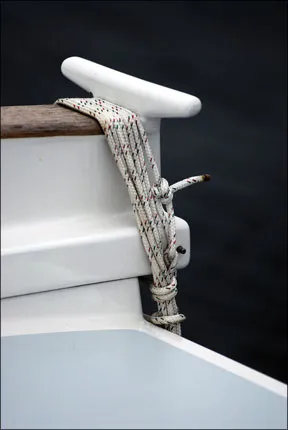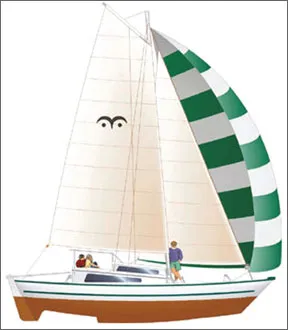
Photos by Ralph Naranjo
Part of the catamaran designer James Wharrams success story lies in the lifestyle he has been marketing along with his boats. For decades, like fellow cat-cult heroes Arthur Piver and Jim Brown, he has launched people as well as boats on voyages of discovery. He pitches the case for Spartan simplicity and self-reliance and backs it up with a forthright and savvy boatbuilding syllabus. His is the anathema of the ferro-cement craze, more of a “do with less” rather than “load her up” mindset. He sells his ideas as effectively as any self-help telemarketer, and his elixir to cure a mundane life ashore makes much more sense.
Those who drop in on Wharrams website www.wharram.com are encouraged to buy a pithy, 72-page book thats an unabashed advertisement for Wharrams boats, the practicality of his approach, and the need to shrug off shoreside claptrap and clutter when going to sea. This diehard pitch in support of adventure is infectious, and Wharram spells out how a handy, but not professionally trained, do-it-yourselfer can succeed with his designs.
The semi-hooked can order “study plans” of one or more of the Wharram lines, and the subject of this review-the Tiki 30-is part of the Coastal Trek series. These study plans afford greater specific detail about Wharram designs and spell out the materials needed. They also lead you through a materials tally that includes details about epoxy resin, plywood types, sails, hardware, lines, an outboard auxiliary, and other bits and pieces.
Once you have figured out where you can come up with an average of 900 hours of free time-Wharrams DIY labor estimate-you may be close to plunking down $1,000 for detailed building plans. Those who take the leap and create their boat from scratch say it was worth the investment. Those who also complete the voyage they dreamed about have even more good things to say about the “Wharram Way.”
“Living on the sea” is one of Wharrams favorite phrases, and in many ways, hes as much a cruising enabler as he is a boat designer. Like Brown, and his lure of “Seasteading,” Wharram dangles a mostly realistic getaway plan in front of potential clients. The price point is attractive, at least as long as one views the labor commitment as part of the recreational experience. But when all the glue and paint has finally cured, the bottom line is that the Tiki 30, and most of the other Wharram cats, are best suited to cruisers willing to slip away without huge battery banks, large-volume water tanks, and with less mechanical propulsion reliance. Theres little sense in fitting granite countertops and aiming for a monohull-like interior in the limited space available aboard these catamarans.
One Particular Tiki
Occasionally, we take a close look at a non-mainstream vessel, believing that the old adage “one size fits all” has less merit among sailors. And near the top of our “cult following” list of sailboats are the Wharram-designed fleet of catamarans that are built by dedicated do-it-yourselfers as well as professionals. When we heard that voyager/boatbuilder Dave Martin had just finished a Wharram Tiki 30, we knew that the timing was right for a look at a unique vessel, its crew, and the designer.
A Rare breed
Dave and Jaja Martin and their three children are among the rarest breed of family cruisers, a couple who have sailed and savored the razor-thin edge between high risk and even higher reward. Twenty-plus years ago, when Dave sailed off in his completely restructured and highly modified Cal 25 Direction, he found that single-handing held little appeal. So, after an Atlantic crossing and a Caribbean wedding, he and Jaja followed the tradewind route around the world. The singlehander was now part of a family of five that had outgrown their pocket cruiser. So with a Cal 25 circumnavigation astern, thoughts of a next boat began to take shape.
The curtain lifted on the second act with the Martins rebuilding a 20-year-old, 33-foot steel sloop, literally tearing out the interior and starting from scratch. After an 18-month refit, there came an Arctic adventure that would carry Driver and its crew to Iceland, Norway, Greenland, Newfoundland, and the experience of living aboard during winters in which the rolling sea became as solid as granite. The Martins exemplify voyaging tenacity, but they earn even higher marks for their self-reliance. Theres no sponsorships for their adventures, or independent wealth to fuel a whim. They have taken very modest vessels and turned them into passage-making vehicles able to handle the task at hand. They worked their way around the world and met the locals as participants in their culture rather than as spectators.
Having first met Dave in the Bahamas in 1984 and coaxed him to come work in a boatyard that Practical Sailor Technical Editor Ralph Naranjo was running on Long Island Sound, Naranjo had the good fortune of seeing how seafaring goals and a shipwrights set of skills can set the stage for special cruising opportunities.

except where noted
Act 3 in the Martin saga is like a symphony with a major change in cadence. This time, priorities such as heavy weather survivability, high-volume stowage capacity, and ice resistance were off the drawing board. In their place came priorities such as simplicity and sailing efficiency, along with the imperative that this will be a “from scratch” Dave-built boat. No mean feat in itself, this boat-building endeavor was all the more impressive because the top of the “honey-do list” was a cottage to live in, a shop to work from, and the building of Dave and Jajas dream house. For most of us, this would relegate the boat project to pipedream status, a project that would likely never be started. But for the Martins, in just over a half-dozen years, the trifecta was complete.
The tide has turned, and their family life proceeds with a shoreside cadence. Adolescents are becoming young adults, and the Maine woods rather than a blue horizon dominate the picture. But true to form, as soon as the house was finished, the table saw gathered no rust. Nor did the other tools in the woodshop, as Dave began cutting carefully scribed curves on Okume plywood. One-at-a-time the amas for a 30-foot Tiki filled the extended garage boat shop. The choice of a double- hulled canoe catamaran doesn’t surprise anyone who knows Dave and Jaja. As sailing adventurers, they have yet to sing the same song twice.
Gravitating toward a new mode of cruising, they embraced the theme of light displacement, efficiency under sail, and simplicity. Spartan minimalism is the common thread in this and the other boats of the Martins two exemplary voyages. The elegance in each of these vessels has little to do with opulence, and everything to do with how the boats have fit the job at hand. Simplicity, functionality, and cost effectiveness abound, defining the approach Dave brings to boatbuilding. He still alludes to a down-the-road, larger monohull project for more oceanic adventure, but for now, its all about quick getaways, coastal cruises, light-air sailing, and shoal-draft exploration.
Design Details
The Wharram Tiki design was a natural choice for Dave because the designer has always approached his work from a builder/sailor perspective, rather than as an independent exercise in naval architecture. Simplicity and practicality rule, and in many ways these boats are the extreme opposite of whats displayed at boat shows across the country. Instead of a living room afloat, the Tiki 30 offers wood-grained camp-style accommodations that are enough for a weekend outing, or two-week summer cruises for hardy souls, but will hold little appeal to those looking for a vacation home afloat.
The real genius in this boat comes more from whats not present than whats found on board. No lead, no liners, and no inboard engine adds up to, or more specifically diminishes down to, a displacement that is so light that a low-tech, no-boom small sail plan can provide enough drive to make way, even when the sea surface is mirror smooth. In light zephyrs, this agile cat will tack and make progress to windward. Behaving like a waterbug skittering across the water, the boat reminds the person handling the butter-smooth tiller bar how important efficiency under sail can be.
Like all multihulls, the issue of initial stability is handled by placing the source of buoyancy well away from the centerline of the vessel without creating the skin drag found in a monohull with massive beam. The combination of a high length-to-beam ratio associated with each ama, and ultralight displacement, the Tiki 30 is a thoroughbred when it comes to efficiency and agility.

Thanks to this ultralight displacement status, the Tiki doesn’t need a cloud of sail to deliver light-air efficiency, and Wharram further reduces the need for a tall spar by leveraging aspect ratio through the use of a simple gaff-rigged mainsail. On one hand, the complication of hoisting both a peak and throat halyard adds some extra complexity, but the result is a higher center of effort (CE) with a lower masthead height, and when it comes to building a simple timber spar, it all makes sense. Yes, a carbon spar and PBO rigging would do a better job, but the cost would be more than a DIY builder spends on all of the materials used to build the rest of the boat.
Every multihull designer is concerned about racking or twisting loads induced in a structure as the heeling force and righting moment interplay on rolling sea. Some use massive bridgedeck structures to transfer rig loads from ama to ama. The Tiki 30 incorporates three well-engineered triangular beam structures and a modern rendition of the Polynesian art of lashing canoe hulls together. Care must be taken during construction to make sure that each beam has a flush fit with a well-reinforced portion of the ama deck, and that the polyester double-braid line used for the lashing is tensioned to designer specifications. These rigidly held athwartship supports may creak in a rolling seaway, but the connection between hulls is rugged and long lasting.
Performance
Under sail, the Tiki is an agile and responsive performer. It balances well, and its V-shaped sections and long shallow keel plus outboard rudders provide good directional stability and responsive steering. The underbody configuration allows the cat to be safely beached, and the complexity of dagger boards is eliminated. The lack of daggerboards has its drawback: Theres less windward capability, but the V-shaped hulls and long run of shallow keel does pretty well to windward without them.
Perhaps the most rigid design characteristic that can’t be circumvented is the importance of keeping its payload in check. This is a boat designed to stay on its lines not bog down and suffer the consequences of excess drag. Its long, lean amas knife through the sea, but their ability to put up with excess weight is minimal. More weight necessitates additional buoyancy, and as the V-shaped sections are submerged, significant increases in skin drag occur along with a loss of vital freeboard. This runs contrary to the design attributes of the vessel and results in performance setbacks and poor sea-keeping ability.
These fast, nimble, cost-effective cats garner a following among do-it-yourself builders because they are efficient to build. Wharrams streamlined approach to construction is a comprehensive blend of materials and hull-shape development that results in a strong, light structure. The expedited build process is free of finicky labor-intensive work and costly esoteric materials. In essence, Wharrams approach uses a minimal strong back, a stitch-and-glue joining process, and lines that allow large scarf-joined panels of high-quality marine plywood to be bent into the shape of a double-canoe catamaran. Bulkheads act as the athwartship formers, and as Wharram puts it, the builder uses a thickened epoxy filleting compound to “weld” the wood together.
Conclusion
The Tiki 30 is well-tailored for Spartan coastal cruising but a bit gossamer for ocean passagemaking, despite the fact that many have done so. Its ability to tuck into tight places, to perform admirably under power with only a 9.9-horsepower long-shaft, four-stroke kicker and its ability under sail give it high marks in our book. For many, camper/cruiser comfort is enough, and with the easy unfurling of a full cockpit awning, the boat becomes spacious enough at anchor to fulfill the dreams of a vacation cruise.
The Tiki is indeed a versatile platform, a pleasure to sail, and a project worth tackling if youre not too worried about dollars and cents. Wharram boats backyard-built pedigrees and their fringe appeal make them a tough sell on the used boat market, so if you plan to build one, you had better plan to sail it.








































Hi and hope all is well!
In the attached pictures you can see what has been done and where I am at this point (60% complete)… I live in Connecticut and in a perfect world, I would like someone to take it over- either with me or partnered or to just buy me out outright… The boat is amazingly special and needs to be finished and/or needs the right home… Any suggestions? 860-573-1154 -Johnny
It’s Wharram Tiki 30 BTW – Johnny
Few years too late probably but worth a shot, still there John?